Hadean Chess!
Introducing the Flying Warmachines, the Flying Elephants, the Ferz Sorcerer, the Wazir Sorcerer, the Ferz Knight, the Wazir Knight, and the Ninja Pawns.
Hadean chess is a large board dozenal system with two pairs of linear jumpers: the Flying Elephants and Flying Warmachines, as well as long reaching leapers: the Ferz Sorcerer and the Wazir Sorcerer. The knights are also augmented with ferz or wazir step movements so that their power is compatible with the the new pieces. Additionally, a new type of pawn: the Ninja Pawn increases the role of pawn play in this game.
This game is very close to Herculean Chess except that two pairs of short-range pieces replace their long-range counterparts.
The Number 12
The number 12 is of major significance in this game.
The warmachines and war elephants can slide to ¼ of the board length.
Similarly, the Zebra and Knight compound pieces can leap or step to a maximum of 12 squares.
Features
- Dozenal (12x12) board system adds more fighting space and retains perfect symmetry
- Short-range pieces: Flying Elephants and Flying War Machines can leap or slide to 2 or 3 squares in diagonal or orthogonal directions respectively.
- Augmented Knights: The Ferz Knight and Wazir Knight have a unique stepping ability which make them more effective short range pieces.
- Extended Leaping Pieces: Play with the unique long leaping pieces: the Ferz-Sorcerer and Wazir Sorcerer that match the Ferz-Knight and the Wazir Knight perfectly.
- 10 ninja pawns, with their enhanced lateral movement, and ability to capture sideways when in enemy territory, add to the regular army of infantry pawns, and guarantee a game with more emphasis on pawn play.
- Flexible Castling (King can move 1-5 steps towards rook) enables more offensive maneuvers as well as quicker development.
- Much greater opening variety with thousands of openings yet to be discovered.
| Board Configuration | |
|---|---|
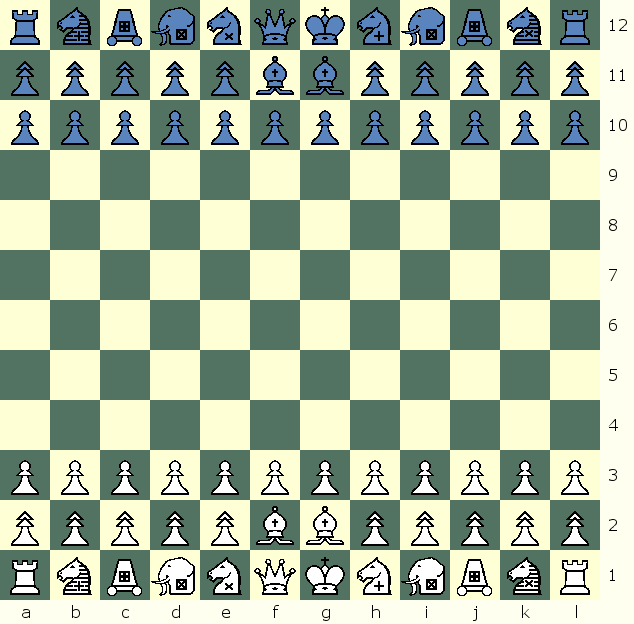 |
Hadean Chess Main Configuration
Coordinates for white. (black mirrors white) Rooks on a1, l1 Wazir Sorcerer on b1 Flying Warmachines on c1,j1 Flying Elephants on d1, i1 Ferz Knight on e1 Queen on f1 King on g1 Wazir Knight on h1 Ferz Sorcerer on k1 Ninja Pawns on a2-e2 and h2-l2 Bishops on f2 and g2 Pawns from a3-l3 |
The Pieces
The Bishop, Rook, Queen and King move as in Orthodox Chess. The Castling move between King and Rook has been modified as explained in rules below.The Pawn
The pawn moves the same as in standard chess except that it can move forward 1,2 or 3 vacant spaces on its first move, or reserve the option to move forward two spaces on its second move if it moved only 1 space or captured from its starting position. Fast pawn update: Once it crosses the middle it can move 1 or 2 spaces forward!The Ninja Pawn
The ninja pawn possesses slightly different modes of movement and capture depending on which half of the board it is on.
Movement:
The ninja pawn can always move 1 square up or 1 square sideways to an empty square regardless of where it is situated on the board.
Once it reaches the middle, the ninja pawn can only move forward 1 square to reach enemy terrirotry if unblocked (cross the middle or invisible red line/river). Fast pawn update: Once it crosses the middle though, it can move 1 or 2 spaces forward if not blocked in addition to moving/capturing 1 square horizontally!
Capture:
Like the standard pawn it can capture one square diagonally up, regardless of which half of the board it is on.
When the ninja pawn is on the top half of board (White after rank 6, Black before rank 7) , it can also capture one square horizontally.
There is no en passant. It cannot capture another pawn or ninja pawn en passant nor can any other pawn capture it this way.
Promotion: The ninja pawn promotes on the last row (rank 12 for white, rank 1 for black), to any piece. Promotion to a piece is mandatory so it would cease to be a pawn in the last row.
The Flying Warmachine
The Flying Warmachine possesses multiple modes of movement and capture.- It can move along any clear orthogonal path up to 3 squares like a short-range rook.
- It can jump over an orthogonal adjacent piece like a 2 space leaper such as a war machine.
- It can jump over two adjacent pieces landing three orthogonal squares away. It can make this jump only if two pieces (regardless of color) lie between it and the target square. Note that it can NEVER jump 3 squares away if only one piece lies in between.
- It can capture the first enemy piece it bumps into on its 3 square clear orthogonal path.
- It can also capture enemy piece two squares away by jumping an adjacent piece.
- It can capture enemy piece three squares away by jumping two adjacent pieces. Note there must be 2 pieces in between for the flying warmachine to jump 3 squares away.
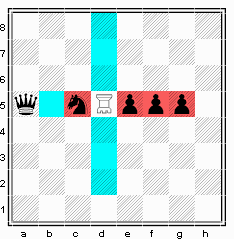 |
The Flying Warmachine on d5 can move to all the squares in blue or capture all the enemy pieces shown except the queen.
It can capture the knight by moving to c5. It can also jump to b5 without capturing the knight. It cannot however capture the queen since two pieces do not lie in between. It can slide one step to the right and capture the pawn at e5 or jump two spaces and capture the pawn at f5 or jump three spaces capturing pawn at g5. |
The Flying Elephant
The Flying Elephant possesses multiple modes of movement and capture.- It can move along any clear diagonal path up to 3 squares like a short-range Bishop.
- It can jump over one diagonal adjacent piece like an Alfil or Elephant.
- It can jump over two adjacent pieces landing three diagonal squares away. It can make this jump only if two pieces (regardless of color) lie between it and the target square. Note that it can NEVER jump 3 squares away if only one piece lies in between.
- It can capture the first enemy piece it bumps into on a clear diagonal path.
- It can capture enemy piece two squares away by jumping an adjacent piece.
- It can capture enemy piece three squares away by jumping two adjacent pieces.
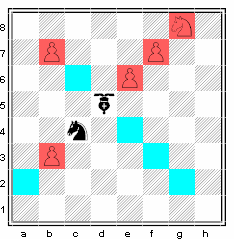 |
The Flying Elephant on d5 can move to all the squares in blue or capture all the enemy pieces shown in red squares.
It can capture the pawn by moving to e6. It can jump and capture pawn at f7 or jump and capture knight on g8. It can jump over the black knight and capture the pawn at b3. It can also slide towards b7 and capture the pawn. |
The Ferz-Sorcerer
- It can move one diagonal step in any direction.
- It can leap to any path traced out by two diagonal spaces followed by one orthogonal square outwards (135 degrees angle).
- It captures on the square it lands. Leaped over pieces are unaffected.
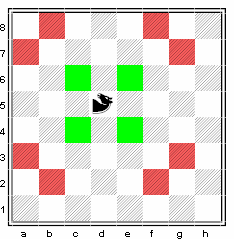 |
The Ferz-Sorcerer on d5 can move to all the squares in green.
It can also leap to all the squares in red. |
The Wazir-Sorcerer
- It can move one orthogonal step in any direction.
- It can leap to any path traced out by one orthogonal square followed by two diagonally outwards (135 degrees angle).
- It captures on the square it lands. Leaped over pieces are unaffected.
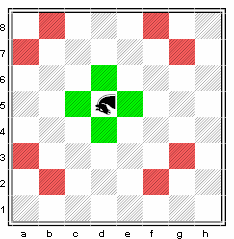 |
The Wazir-Sorcerer on d5 can move to all the squares in green.
It can also leap to all the squares in red. |
The Ferz-Knight
- It can move one diagonal step in any direction.
- It can leap to any path traced out by one diagonal square followed by one orthogonal square outwards (135 degrees angle).
- It captures on the square it lands. Leaped over pieces are unaffected.
The Wazir-Knight
- It can move one orthogonal step in any direction.
- It can leap to any path traced out by one orthogonal square followed by one diagonally outwards (135 degrees angle).
- It captures on the square it lands. Leaped over pieces are unaffected.
All Diags above shows smaller board than that used for game.
Optional Experimental Pieces.
As an experiment, the Flying Ninja Guards and the Flying Ninja Warriors can replace the flying elephants and flying warmachines. These pieces move exactly the same as their counterparts except:- They can fly 3 squares away regardless of how many pieces lie in between i.e even if one piece and a space lie in between it can leap over to the third square unlike the flying elephant and warmachine which are hindered.
- In addition to capturing by replacement they can also capture any enemy pieces they jump over.
Rules
The rules in Hadean Chess are the same as in chess except for the following modifications :-
Castling:
Unlike standard Chess, castling is flexible with the king able to travel 1, 2, 3, 4 or even 5 squares towards the rook.
There are 9 possible castling positions, the most extreme wing castling involves the king relocating to the b or k file. The choice of castling positions will depend on whether it is immediately necessary for the king to be tucked away at the wing or for the rook to be centralized.
The usual castling criteria apply: No piece can occupy the spaces travelled by the king and castling rook. Cannot castle out of check. King cannot pass over or land on squares attacked by enemy, but rook can.-
1 space transposition - King Side Castling
White moves King one space from g1-h1 and rook from l1-g1
Black moves King one space from g12-h12 and rook from l12-g12 -
1 space transposition - Queen Side Castling
White moves King one space from g1-f1 and rook from a1-g1
Black moves King one space from g12-f12 and rook from a12-g12 -
2 space transposition - King Side Castling
White moves King two spaces from g1-i1 and rook from l1-h1
Black moves King two spaces from g12-i12 and rook from l12-h12 -
2 space transposition - Queen Side Castling
White moves King two spaces from g1-e1 and rook from a1-f1
Black moves King two spaces from g12-e12 and rook from a12-f12 -
3 space transposition - King Side Castling
White moves King three spaces from g1-j1 and rook from l1-i1
Black moves King three spaces from g12-j12 and rook from l12-i12 -
3 space transposition - Queen Side Castling
White moves King three spaces from g1-d1 and rook from a1-e1
Black moves King three spaces from g12-d12 and rook from a12-e12 -
4 space transposition - King Side Castling
White moves King four spaces from g1-k1 and rook from l1-j1
Black moves King four spaces from g12-k12 and rook from l12-j12 -
4 space transposition - Queen Side Castling
White moves King four spaces from g1-c1 and rook from a1-d1
Black moves King four spaces from g12-c12 and rook from a12-d12 -
5 space transposition - Queen Side Castling
White moves King five spaces from g1-b1 and rook from a1-c1
Black moves King five spaces from g12-b12 and rook from a12-c12
-
1 space transposition - King Side Castling
-
Pawn Movement ():
The pawn can move from its original position either 1, 2 or 3 vacant squares forward.
A pawn, which initially moved forward 1 square or captured from its starting position, can subsequently at any time move forward 1 or 2 vacant squares. Once it reaches the center of the board (rank 6 for white, rank 7 for black), it can move forward only one square at a time.
Some examples: the white pawn at g3 can start g3-g6 or it can move g3-g5 then g5-g6, or g3-g4 followed by g4-g6, or move g3-h4 to capture enemy piece at h4 followed by h4-h6 next time it moves. - En Passant: If a Pawn moves two or three squares initially and passes an enemy Pawn on the
5th or 6th rank, it may be captured en passant by the enemy pawn.
E.g. White pawn on a3 black pawn on b5. White a3 - a6 (or a5), the black pawn on b4 can capture it as if it had moved to a4.
Similarly, black pawn on b6 instead and white plays a3 -a6 then the black pawn can capture the white pawn as if it moved to a5. Note in this case the white pawn can still avoid the black pawn by moving to a4 instead.
If a pawn slides forward 2 squares on its second move, it can also be captured en passant by an opposing pawn on the 6th rank. E.g. white pawn on a4 and black pawn on b6. White plays a4-a6, black pawn on b6 can capture the pawn en passant by moving to a5.
Capturing en passant is optional unless it is the only legal move available. The capture must be made on the next move. - Pawn promotion: Pawns can promote to any piece (except the ninja pawn) on the 12th rank only.
Compare to Standard Chess
There are some key differences from standard chess:- The larger board and more pieces imply a much longer drawn out war between both sides.
- The original starting configuration is much safer so one side cannot aggress and charge very quickly. Since there are no weak points to hit immediately as in standard chess, White does not have an appreciable advantage.
- Larger board and more pieces make it more difficult for even high level players to learn all opening variations several levels deep. Thus, more over the board play is guaranteed even at the highest levels.
- The Ninja Pawns add a rich strategic dimension to pawn play. It is not uncommon for the standard pawns to move forward into enemy territory paving the way for the ninja pawns.
- The added stepping movement of the knights drastically improves their short range versatility.
- Piece Values:
The Flying Elephant is worth a little less than the bishop while the Flying Warmachine is worth about ½ a pawn more than the bishop.
The Ferz-Sorcerer and Wazir-Sorcerer may be worth approximately a little less than their Knight counterparts and perhaps slightly less if not equal to the bishop. The Wazir Knight may be worth more than the Ferz-knight, and both knights may be close to or even a little more than the bishop.
The Queen, Rook and Bishop increase their power substantially relative to pawns especially when the board is less crowded.
The Ninja Pawn is worth about one and a half to twice the value of a pawn.
Play
A free registration at chessvariants.org is required to play the game.Play Main A Game of Hadean Chess
View Game Logs for Hadean Chess at chessvariants.org
 Download Zillions of Games File
Download Zillions of Games File
|
Navigate To: |
|
Introduction Board Setup Rules Pieces Comparison to Chess Play the game |
|
If you would like to email the chess variant inventor directly: inventor@chess.computerwebservices.net
|
|
Posted by: memaster on 2020-12-05 12:40:17 Like Chess: YES
BIg chess |

